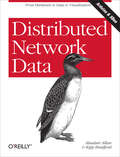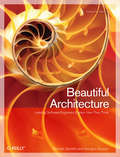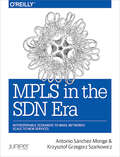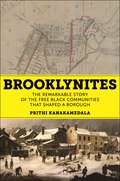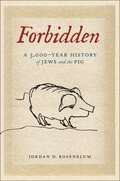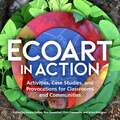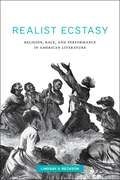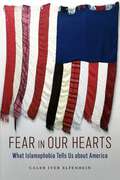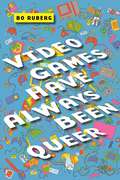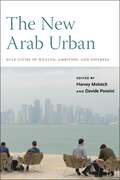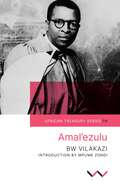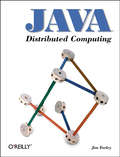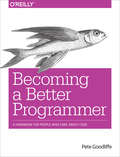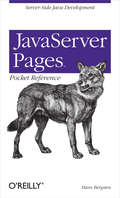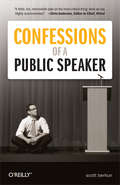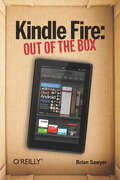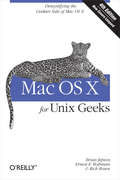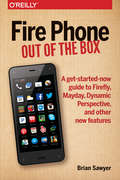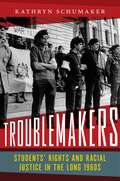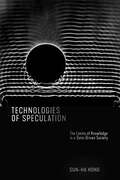- Table View
- List View
Distributed Network Data: From Hardware to Data to Visualization
by Alasdair Allan Kipp BradfordBuild your own distributed sensor network to collect, analyze, and visualize real-time data about our human environment—including noise level, temperature, and people flow. With this hands-on book, you’ll learn how to turn your project idea into working hardware, using the easy-to-learn Arduino microcontroller and off-the-shelf sensors.Authors Alasdair Allan and Kipp Bradford walk you through the entire process, from prototyping a simple sensor node to performing real-time analysis on data captured by a deployed multi-sensor network. Demonstrated at recent O’Reilly Strata Conferences, the future of distributed data is already here. If you have programming experience, you can get started immediately.Wire up a circuit on a breadboard, and use the Arduino to read values from a sensorAdd a microphone and infrared motion detector to your circuitMove from breadboard to prototype with Fritzing, a program that converts your circuit design into a graphical representationSimplify your design: learn use cases and limitations for using Arduino pins for power and groundingBuild wireless networks with XBee radios and request data from multiple sensor platformsVisualize data from your sensor network with Processing or LabVIEW
Beautiful Architecture: Leading Thinkers Reveal the Hidden Beauty in Software Design
by Diomidis Spinellis Georgios GousiosWhat are the ingredients of robust, elegant, flexible, and maintainable software architecture? Beautiful Architecture answers this question through a collection of intriguing essays from more than a dozen of today's leading software designers and architects. In each essay, contributors present a notable software architecture, and analyze what makes it innovative and ideal for its purpose. Some of the engineers in this book reveal how they developed a specific project, including decisions they faced and tradeoffs they made. Others take a step back to investigate how certain architectural aspects have influenced computing as a whole. With this book, you'll discover:How Facebook's architecture is the basis for a data-centric application ecosystemThe effect of Xen's well-designed architecture on the way operating systems evolveHow community processes within the KDE project help software architectures evolve from rough sketches to beautiful systemsHow creeping featurism has helped GNU Emacs gain unanticipated functionalityThe magic behind the Jikes RVM self-optimizable, self-hosting runtimeDesign choices and building blocks that made Tandem the choice platform in high-availability environments for over two decadesDifferences and similarities between object-oriented and functional architectural viewsHow architectures can affect the software's evolution and the developers' engagementGo behind the scenes to learn what it takes to design elegant software architecture, and how it can shape the way you approach your own projects, with Beautiful Architecture.
Programming Entity Framework: Creating and Configuring Data Models from Your Classes
by Julia Lerman Rowan MillerTake advantage of the Code First data modeling approach in ADO.NET Entity Framework, and learn how to build and configure a model based on existing classes in your business domain. With this concise book, you’ll work hands-on with examples to learn how Code First can create an in-memory model and database by default, and how you can exert more control over the model through further configuration.Code First provides an alternative to the database first and model first approaches to the Entity Data Model. Learn the benefits of defining your model with code, whether you’re working with an existing database or building one from scratch. If you work with Visual Studio and understand database management basics, this book is for you.Learn exactly what Code First does—and does not—enable you to doUnderstand how property attributes, relationships, and database mappings are inferred from your classes by Code FirstUse Data Annotations and the Fluent API to configure the Code First data modelPerform advanced techniques, such as controlling the database schema and overriding the default model cachingThis book is a continuation of author Julia Lerman’s Programming Entity Framework, widely recognized as the leading book on the topic.
MPLS in the SDN Era: Interoperable Scenarios to Make Networks Scale to New Services
by Antonio Sanchez Monge Krzysztof Grzegorz SzarkowiczHow can you make multivendor services work smoothly on today’s complex networks? This practical book shows you how to deploy a large portfolio of multivendor Multiprotocol Label Switching (MPLS) services on networks, down to the configuration level. You’ll learn where Juniper Network's Junos, Cisco's IOS XR, and OpenContrail, interoperate and where they don’t.Two network and cloud professionals from Juniper describe how MPLS technologies and applications have rapidly evolved through services and architectures such as Ethernet VPNs, Network Function Virtualization, Seamless MPLS, Egress Protection, External Path Computation, and more. This book contains no vendor bias or corporate messages, just solid information on how to get a multivendor network to function optimally.Topics include:Introduction to MPLS and Software-Defined Networking (SDN)The four MPLS Builders (LDP, RSVP-TE, IGP SPRING, and BGP)Layer 3 unicast and multicast MPLS services, Layer 2 VPN, VPLS, and Ethernet VPNInter-domain MPLS ServicesUnderlay and overlay architectures: data centers, NVO, and NFVCentralized Traffic Engineering and TE bandwidth reservationsScaling MPLS transport and servicesTransit fast restoration based on the IGP and RSVP-TEFIB optimization and egress service for fast restoration
Brooklynites: The Remarkable Story of the Free Black Communities that Shaped a Borough
by Prithi Kanakamedala2025 Gotham Book Prize FinalistMeet the Black Brooklynites who defined New York City’s most populous borough through their search for social justiceBefore it was a borough, Brooklyn was our nation’s third largest city. Its free Black community attracted people from all walks of life—businesswomen, church leaders, laborers, and writers—who sought to grow their city in a radical anti-slavery vision. The residents of neighborhoods like DUMBO, Fort Greene, and Williamsburg organized and agitated for social justice. They did so even as their own freedom was threatened by systemic and structural racism, risking their safety for the sake of their city. Brooklynites recovers the lives of these remarkable citizens and considers their lasting impact on New York City’s most populous borough.This cultural and social history is told through four ordinary families from Brooklyn’s nineteenth-century free Black community: the Crogers, the Hodges, the Wilsons, and the Gloucesters. The book illustrates the depth and scope of their activism, cementing Brooklyn’s place in the history of social justice movements. Their lives offer valuable lessons on freedom, democracy, and family—both the ones we’re born with and the ones we choose. Their powerful stories continue to resonate today, as borough residents fill the streets in search of a more just city.This is a story of land, home, labor, of New Yorkers past, and the legacy they left us. This is the story of Brooklyn.
Forbidden: A 3,000-Year History of Jews and the Pig
by Jordan D. RosenblumWinner of the 74th National Jewish Book Award: The Jane and Stuart Weitzman Family Award for Food Writing and CookbooksA surprising history of how the pig has influenced Jewish identityJews do not eat pig. This (not always true) observation has been made by both Jews and non-Jews for more than three thousand years and is rooted in biblical law. Though the Torah prohibits eating pig meat, it is not singled out more than other food prohibitions. Horses, rabbits, squirrels, and even vultures, while also not kosher, do not inspire the same level of revulsion for Jews as the pig. The pig has become an iconic symbol for people to signal their Jewishness, non-Jewishness, or rebellion from Judaism. There is nothing in the Bible that suggests Jews are meant to embrace this level of pig-phobia.Starting with the Hebrew Bible, Jordan D. Rosenblum historicizes the emergence of the pig as a key symbol of Jewish identity, from the Roman persecution of ancient rabbis, to the Spanish Inquisition, when so-called Marranos (“Pigs”) converted to Catholicism, to Shakespeare’s writings, to modern memoirs of those leaving Orthodox Judaism. The pig appears in debates about Jewish emancipation in eighteenth-century England and in vaccine conspiracies; in World War II rallying cries, when many American Jewish soldiers were “eating ham for Uncle Sam;” in conversations about pig sandwiches reportedly consumed by Karl Marx; and in recent deliberations about the kosher status of Impossible Pork.All told, there is a rich and varied story about the associations of Jews and pigs over time, both emerging from within Judaism and imposed on Jews by others. Expansive yet accessible, Forbidden offers a captivating look into Jewish history and identity through the lens of the pig.
Ecoart in Action: Activities, Case Studies, and Provocations for Classrooms and Communities
by Amara Geffen, Ann Rosenthal, Chris Fremantle, and Aviva RahmaniReady-to-go, vetted approaches for facilitating artistic environmental projectsHow do we educate those who feel an urgency to address our environmental and social challenges? What ethical concerns do art-makers face who are committed to a deep green agenda? How can we refocus education to emphasize integrative thinking and inspire hope? What role might art play in actualizing environmental resilience?Compiled from 67 members of the Ecoart Network, a group of more than 200 internationally established practitioners, Ecoart in Action stands as a field guide that offers practical solutions to critical environmental challenges. Organized into three sections—Activities, Case Studies, and Provocations—each contribution provides models for ecoart practice that are adaptable for use within a variety of classrooms, communities, and contexts. Educators developing project and place-based learning curricula, citizens, policymakers, scientists, land managers, and those who work with communities (human and other) will find inspiration for integrating art, science, and community-engaged practices into on-the-ground environmental projects. If you share a concern for the environmental crisis and believe art can provide new options, this book is for you!
Realist Ecstasy: Religion, Race, and Performance in American Literature (Performance and American Cultures #2)
by Lindsay V. RecksonHonorable Mention, Barnard Hewitt Award from the American Society for Theater ResearchExplores the intersection and history of American literary realism and the performance of spiritual and racial embodiment. Recovering a series of ecstatic performances in late nineteenth- and early twentieth-century American realism, Realist Ecstasy travels from camp meetings to Native American ghost dances to storefront church revivals to explore realism’s relationship to spiritual experience. In her approach to realism as both an unruly archive of performance and a wide-ranging repertoire of media practices—including literature, photography, audio recording, and early film—Lindsay V. Reckson argues that the real was repetitively enacted and reenacted through bodily practice. Realist Ecstasy demonstrates how the realist imagining of possessed bodies helped construct and naturalize racial difference, while excavating the complex, shifting, and dynamic possibilities embedded in ecstatic performance: its production of new and immanent forms of being beside. Across her readings of Stephen Crane, James Weldon Johnson, and Nella Larsen, among others, Reckson triangulates secularism, realism, and racial formation in the post-Reconstruction moment. Realist Ecstasy shows how post-Reconstruction realist texts mobilized gestures—especially the gestures associated with religious ecstasy—to racialize secularism itself. Reckson offers us a distinctly new vision of American realism as a performative practice, a sustained account of how performance lives in and through literary archives, and a rich sense of how closely secularization and racialization were linked in Jim Crow America.
Fear in Our Hearts: What Islamophobia Tells Us about America (North American Religions #5)
by Caleb Iyer ElfenbeinArgues that anti-Muslim activity reveals how fear is corroding core American valuesIn a 2018 national poll, over ninety percent of respondents reported that treating people equally is an essential American value. Almost eighty percent said accepting people of different racial backgrounds is very important. Yet about half of the general public reported that they doubt whether Muslims can truly dedicate themselves to American values and society. Why do many people who say they believe in equality and acceptance of those of different backgrounds also think that Muslims could be an exception to that rule?In Fear in Our Hearts, Caleb Iyer Elfenbein examines Islamophobia in the United States, positing that rather than simply being an outcome of the 9/11 attacks, anti-Muslim activity grows out of a fear of difference that has always characterized US public life. Elfenbein examines the effects of this fear on American Muslims, as well as describing how it works to shape and distort American society. Drawing on over 1,800 news reports documenting anti-Muslim activity, Elfenbein pinpoints trends, draws connections to the broader histories of immigration, identity, belonging, and citizenship in the US, and examines how Muslim communities have responded.In the face of public fear and hate, American Muslim communities have sought to develop connections with non-Muslims through unprecedented levels of community transparency, outreach, and public engagement efforts. Despite the hostile environment that has made these efforts necessary, American Muslims have faced down their own fears to offer a model for building communities and creating more welcoming conditions of public life for everyone.Arguing that anti-Muslim activity tells us as much about the state of core American values in general as it does about the particular experiences of American Muslims, this compelling look at Muslims in America offers practical ideas about how we can create a more welcoming public life for all in our everyday lives.
Video Games Have Always Been Queer (Postmillennial Pop #16)
by Bo RubergArgues for the queer potential of video gamesWhile popular discussions about queerness in video games often focus on big-name, mainstream games that feature LGBTQ characters, like Mass Effect or Dragon Age, Bonnie Ruberg pushes the concept of queerness in games beyond a matter of representation, exploring how video games can be played, interpreted, and designed queerly, whether or not they include overtly LGBTQ content. Video Games Have Always Been Queer argues that the medium of video games itself can—and should—be read queerly.In the first book dedicated to bridging game studies and queer theory, Ruberg resists the common, reductive narrative that games are only now becoming more diverse. Revealing what reading D. A. Miller can bring to the popular 2007 video game Portal, or what Eve Sedgwick offers Pong, Ruberg models the ways game worlds offer players the opportunity to explore queer experience, affect, and desire. As players attempt to 'pass' in Octodad or explore the pleasure of failure in Burnout: Revenge, Ruberg asserts that, even within a dominant gaming culture that has proved to be openly hostile to those perceived as different, queer people have always belonged in video games—because video games have, in fact, always been queer.
The New Arab Urban: Gulf Cities of Wealth, Ambition, and Distress
by Harvey Molotch and Davide PonziniCities of the Arabian Peninsula reveal contradictions of contemporary urbanizationThe fast-growing cities of the Persian Gulf are, whatever else they may be, indisputably sensational. The world’s tallest building is in Dubai; the 2022 World Cup in soccer will be played in fantastic Qatar facilities; Saudi Arabia is building five new cities from scratch; the Louvre, the Guggenheim and the Sorbonne, as well as many American and European universities, all have handsome outposts and campuses in the region. Such initiatives bespeak strategies to diversify economies and pursue grand ambitions across the Earth.Shining special light on Dubai, Abu Dhabi, and Doha—where the dynamics of extreme urbanization are so strongly evident—the authors of The New Arab Urban trace what happens when money is plentiful, regulation weak, and labor conditions severe. Just how do authorities in such settings reconcile goals of oft-claimed civic betterment with hyper-segregation and radical inequality? How do they align cosmopolitan sensibilities with authoritarian rule? How do these elite custodians arrange tactical alliances to protect particular forms of social stratification and political control? What sense can be made of their massive investment for environmental breakthrough in the midst of world-class ecological mayhem?To address such questions, this book’s contributors place the new Arab urban in wider contexts of trade, technology, and design. Drawn from across disciplines and diverse home countries, they investigate how these cities import projects, plans and structures from the outside, but also how, increasingly, Gulf-originated initiatives disseminate to cities far afield.Brought together by noted scholars, sociologist Harvey Molotch and urban analyst Davide Ponzini, this timely volume adds to our understanding of the modern Arab metropolis—as well as of cities more generally. Gulf cities display development patterns that, however unanticipated in the standard paradigms of urban scholarship, now impact the world.
Bottoms Up: Queer Mexicanness and Latinx Performance (Sexual Cultures)
by Xiomara Verenice Cervantes-GomezProposes a queer way to be in the world and with othersInvoking queer aesthetics, ethics, and politics, Bottoms Up explores a sexual way to be with others while living with loss. Xiomara Cervantes-Gómez demonstrates how aesthetic representations of sex—namely, bottoming—function as allegorical paradigms, revealing the assemblages of violence that have constituted the social, cultural, and political shifts of Mexico and US Latinx culture from 1950 to the present.With playful, theoretically nuanced prose, Cervantes-Gómez builds upon queer of color theory and continental philosophy to present the “bottom” as a form of relational performance, which she terms “pasivo ethics.” The argument develops through a series of compelling case studies, including a series of novels by Octavio Paz and Luis Zapata that trace the position of the bottom in Mexican nationalist literature; the forms of exposure, risk, and proximity in the performance work of artist Lechedevirgen Trimegisto; a reading of violence and the erotic in the work of artist Bruno Ramri; and reading artists such as Yosimar Reyes, Yanina Orellana, and Carlos Martiel as they build a framework of sexual inheritance that carries the traumas of Mexicanness into the diaspora.Through a broad archive rooted in hemispheric Latinx performance, Bottoms Up considers how sexual and political power are bound up with each other in the shaping of Mexicanness. Placing particular emphasis on questions of queer and trans Mexican embodiment, the book explains how Mexicanness is constituted through discourses of exposure.
Amal’ezulu
by Benedict Wallet VilakaziAmal’ezulu (Zulu Horizons), first published in 1945 in the Bantu (later, African) Treasury Series by the University of the Witwatersrand Press, was the second volume of poetry produced by the renowned Zulu author B.W. Vilakazi. It was written during the ten years he spent living in Johannesburg, in ‘exile’ from his birthplace, KwaZulu-Natal. The poems in this collection represent a turning point in Vilakazi’s life; they express yearnings for the beloved land, animals and ancestral spirits of his rural home, as well as expressions of deep disillusionment with the urban life he encountered in the ‘City of Gold’, and in particular the suffering of the black miners who brought this gold to the surface but never experienced the benefits of the wealth it produced for the mine owners. Vilakazi was deeply conscious of the subhuman system that held these miners in its grip, and gave voice to their suffering in many of the poems in the collection, in particular the now famous poem ‘Ezinkomponi’ (‘On the mine compounds’).Renowned as the father of Nguni literature, Vilakazi was both a traditional imbongi (bard) and a forward-looking poet who could fuse Western poetic forms with Zulu izibongo (praise poetry). In these poems he assumes the role of the voice of the voiceless, and gives poignant expression to the stoic endurance of those caught up in the brutalities of capitalist exploitation of African labour, and the appalling injustices of the migrant labour system.
Asterisk Cookbook: Solutions to Everyday Telephony Problems
by Leif Madsen Russell BryantAsterisk has a wealth of features to help you customize your PBX to fill very specific business needs. This short cookbook offers recipes for tackling dialplan fundamentals, making and controlling calls, and monitoring channels in your PBX environment. Each recipe includes a simple code solution you can put to work immediately, along with a detailed discussion that offers insight into why and how the recipe works.This book focuses on Asterisk 1.8, although many of the conventions and information presented are version-agnostic. These recipes include solutions to help you:Authenticate callers before moving on in your dialplanRedirect calls received by your auto-attendantCreate an automatic call-back serviceInitiate hot-desking to login to and accept calls at any office deviceMonitor and interrupt live calls to train new employees at a call centerRecord calls from your Asterisk dialplan
Java Distributed Computing (Java Series)
by Jim FarleyDistributed computing and Java go together naturally. As the first language designed from the bottom up with networking in mind, Java makes it very easy for computers to cooperate. Even the simplest applet running in a browser is a distributed application, if you think about it. The client running the browser downloads and executes code that is delivered by some other system. But even this simple applet wouldn't be possible without Java's guarantees of portability and security: the applet can run on any platform, and can't sabotage its host.Of course, when we think of distributed computing, we usually think of applications more complex than a client and server communicating with the same protocol. We usually think in terms of programs that make remote procedure calls, access remote databases, and collaborate with others to produce a single result. Java Distributed Computing discusses how to design and write such applications. It covers Java's RMI (Remote Method Invocation) facility and CORBA, but it doesn't stop there; it tells you how to design your own protocols to build message passing systems and discusses how to use Java's security facilities, how to write multithreaded servers, and more. It pays special attention to distributed data systems, collaboration, and applications that have high bandwidth requirements.In the future, distributed computing can only become more important.Java Distributed Computing provides a broad introduction to the problems you'll face and the solutions you'll find as you write distributed computing applications.Topics covered in Java Distributed Computing:Introduction to Distributed ComputingNetworking BasicsDistributed Objects (Overview of CORBA and RMI)ThreadsSecurityMessage Passing SystemsDistributed Data Systems (Databases)Bandwidth Limited ApplicationsCollaborative Systems
Becoming a Better Programmer: A Handbook for People Who Care About Code
by Pete GoodliffeIf you’re passionate about programming and want to get better at it, you’ve come to the right source. Code Craft author Pete Goodliffe presents a collection of useful techniques and approaches to the art and craft of programming that will help boost your career and your well-being.Goodliffe presents sound advice that he’s learned in 15 years of professional programming. The book’s standalone chapters span the range of a software developer’s life—dealing with code, learning the trade, and improving performance—with no language or industry bias. Whether you’re a seasoned developer, a neophyte professional, or a hobbyist, you’ll find valuable tips in five independent categories:Code-level techniques for crafting lines of code, testing, debugging, and coping with complexityPractices, approaches, and attitudes: keep it simple, collaborate well, reuse, and create malleable codeTactics for learning effectively, behaving ethically, finding challenges, and avoiding stagnationPractical ways to complete things: use the right tools, know what “done” looks like, and seek help from colleaguesHabits for working well with others, and pursuing development as a social activity
JavaServer Pages Pocket Reference: Server-Side Java Development
by Hans BergstenJavaServer Pages (JSP) is harmonizing how web designers and programmers create dynamic web pages. The reason for this is simple: JSP capitalizes on the power of Java servlets to create effective, reusable web applications.JSP allows you to develop robust, powerful web content, and the best part is that you're not required to be a hard-core Java programmer.JavaServer Pages Pocket Reference is the perfect companion volume to O'Reilly's best-selling JavaServer Pages, also by Hans Bergsten. This book provides detailed coverage of JSP syntax and processing, directive elements, standard action elements, scripting elements, implicit objects, custom actions, tag library description creation, and WARs.
Confessions of a Public Speaker
by Scott BerkunIn this hilarious and highly practical book, author and professional speaker Scott Berkun reveals the techniques behind what great communicators do, and shows how anyone can learn to use them well. For managers and teachers -- and anyone else who talks and expects someone to listen -- Confessions of a Public Speaker provides an insider's perspective on how to effectively present ideas to anyone. It's a unique, entertaining, and instructional romp through the embarrassments and triumphs Scott has experienced over 15 years of speaking to crowds of all sizes.With lively lessons and surprising confessions, you'll get new insights into the art of persuasion -- as well as teaching, learning, and performance -- directly from a master of the trade.Highlights include:Berkun's hard-won and simple philosophy, culled from years of lectures, teaching courses, and hours of appearances on NPR, MSNBC, and CNBCPractical advice, including how to work a tough room, the science of not boring people, how to survive the attack of the butterflies, and what to do when things go wrongThe inside scoop on who earns $30,000 for a one-hour lecture and whyThe worst -- and funniest -- disaster stories you've ever heard (plus countermoves you can use)Filled with humorous and illuminating stories of thrilling performances and real-life disasters, Confessions of a Public Speaker is inspirational, devastatingly honest, and a blast to read.
LPI Linux Certification in a Nutshell
by Jeff Dean Bruno Gomes Pessanha Nicolai Langfeldt Steven Pritchard James StangerLPI Linux Certification in a Nutshell,Second Edition is an invaluable resource for determining what you needto practice to pass the Linux Professional Institute exams. This bookwill helpyou determine when you're ready to take the exams, which aretechnically challenging and designed to reflect the skills thatadministrators needin real working environments. As more corporations adopt Linux as the networking backbone for theirIT systems, the demand for certified technicians will becomeeven greater. Passing the LPI exams will broaden your career optionsbecause the LPICis the most widely known and respected Linux certification program intheworld. Linux Journal recognized the LPI as the bestTraining andCertification Program. The exams were developed by the LinuxProfessional Institute,an international, volunteer-driven organization with affiliates in adozen countries. The core LPI exams cover two levels. Level 1 tests a basic knowledge ofLinux installation, configuration, and command-lineskills. Level 2 goes into much more depth regarding systemtroubleshooting andnetwork services such as email and the Web. The second edition of LPILinuxCertification in a Nutshell is a thoroughly researchedreference to these exams. The book is divided into four parts, one foreach of theLPI exams. Each part features not only a summary of the core skills youneed, but sample exercises and test questions, along with helpful hintsto letyou focus your energies. Major topics include: GNU and Unix commandsLinux installation and package managementDevices, filesystems, and kernel configurationText editing, processing, and printingThe X Window SystemNetworking fundamentals and troubleshootingSecurity, including intrusion detection, SSH, Kerberos, andmoreDNS, DHCP, file sharing, and other networking infrastructureEmail, FTP, and Web services Praise for the first edition:"Although O'Reilly's Nutshell series are intended as 'DesktopReference' manuals, I have to recommend this one as a goodall-round read; not only as a primer for LPI certification, but as anexcellent introductory text on GNU/Linux. In all, this is a valuableaddition toO'Reilly's already packed stable of Linux titles and I look forward tomore from the author."--First Monday
Kindle Fire: Out of the Box
by Brian SawyerWhen you open the box for your brand-new Kindle Fire, you'll find the hottest 7-inch tablet to hit the market, a power adapter, and a "Quick Start Guide" that tells you how to turn it on. But to really take advantage of all the content and features the device has to offer, you'll need a little more. Kindle Fire: Out of the Box gets you up and running beyond the first "Slide to unlock" screen to unlock all of your media from the cloud in the palm of your hand.Whether your media library lives in Amazon Cloud Drive or on your device, the Fire gives you immediate access to all of it, wherever you are, as long as you know where to find it and how to consume it. With Kindle Fire: Out of the Box, you'll jump right in to reading full-color magazines, newspapers, newly enhanced ebooks, and your own personal documents. Quickly download music from your Amazon Cloud Drive or new music from the Amazon MP3 store to listen offline, and get instant, unlimited access to streaming of over 10,000 popular movies and TV shows. And go beyond your own media to experience integrated email, games, Android apps from the Amazon App Store, and ultra-fast web browsing with the revolutionary, cloud-accelerated Silk browser.This intuitive, easy-to-follow ebook opens the world of possibilities made possible by the Kindle Fire, right out of the box.
Mac OS X For Unix Geeks: Demistifying the Geekier Side of Mac OS X
by Brian Jepson Ernest E. Rothman Rich RosenIf you're a developer or system administrator lured to Mac OS X because of its Unix roots, you'll quickly discover that performing Unix tasks on a Mac is different than what you're accustomed to. Mac OS X for Unix Geeks serves as a bridge between Apple's Darwin OS and the more traditional Unix systems. This clear, concise guide gives you a tour of Mac OS X's Unix shell in both Leopard and Tiger, and helps you find the facilities that replace or correspond to standard Unix utilities.You'll learn how to perform common Unix tasks in Mac OS X, such as using Directory Services instead of the standard Unix /etc/passwd and /etc/group, and you'll be able to compile code, link to libraries, and port Unix software using either Leopard and Tiger. This book teaches you to:Navigate the Terminal and understand how it differs from an xtermUse Open Directory (LDAP) and NetInfo as well as Directory ServicesCompile your code with GCC 4Port Unix programs to Mac OS X with FinkUse MacPorts to install free/open source softwareSearch through metadata with Spotlight's command-line utilitiesBuild the Darwin kernelAnd there's much more. Mac OS X for Unix Geeks is the ideal survival guide to tame the Unix side of Leopard and Tiger. If you're a Unix geek with an interest in Mac OS X, you'll soon find that this book is invaluable.
iPhone Forensics: Recovering Evidence, Personal Data, and Corporate Assets
by Jonathan Zdziarski"This book is a must for anyone attempting to examine the iPhone. The level of forensic detail is excellent. If only all guides to forensics were written with this clarity!"-Andrew Sheldon, Director of Evidence Talks, computer forensics expertsWith iPhone use increasing in business networks, IT and security professionals face a serious challenge: these devices store an enormous amount of information. If your staff conducts business with an iPhone, you need to know how to recover, analyze, and securely destroy sensitive data. iPhone Forensics supplies the knowledge necessary to conduct complete and highly specialized forensic analysis of the iPhone, iPhone 3G, and iPod Touch. This book helps you:Determine what type of data is stored on the deviceBreak v1.x and v2.x passcode-protected iPhones to gain access to the deviceBuild a custom recovery toolkit for the iPhoneInterrupt iPhone 3G's "secure wipe" processConduct data recovery of a v1.x and v2.x iPhone user disk partition, and preserve and recover the entire raw user disk partitionRecover deleted voicemail, images, email, and other personal data, using data carving techniquesRecover geotagged metadata from camera photosDiscover Google map lookups, typing cache, and other data stored on the live file systemExtract contact information from the iPhone's database Use different recovery strategies based on case needsAnd more. iPhone Forensics includes techniques used by more than 200 law enforcement agencies worldwide, and is a must-have for any corporate compliance and disaster recovery plan.
Fire Phone: A get-started-now guide to Firefly, Mayday, Dynamic Perspective, and other new features
by Brian SawyerDive straight into hot Fire phone features you won’t find in any other device—like Firefly, Mayday, and Dynamic Perspective—with this concise hands-on guide. You probably already know how to make calls, text, and take photos with Amazon’s new phone, but where it really shines is in innovative features you’ve never even seen before. This intuitive, easy-to-follow book opens a world of possibilities with the Fire phone, right out of the box.Instantly identify and order just about any product with Firefly—from DVDs, CDs, and books (or their electronic equivalents) to nearly anything else with a barcodeUse Mayday to get live, hands-on tech support and customer service right on your phoneImmerse yourself in 3D games, maps, and apps with the Dynamic Perspective sensor systemNavigate easily with new one-handed (and no-handed!) gestures found only on Fire phone
Troublemakers: Students’ Rights and Racial Justice in the Long 1960s
by Kathryn SchumakerA powerful history of student protests and student rights during the desegregation eraIn the late 1960s, protests led by students roiled high schools across the country. As school desegregation finally took place on a wide scale, students of color were particularly vocal in contesting the racial discrimination they saw in school policies and practices. And yet, these young people had no legal right to express dissent at school. It was not until 1969 that the Supreme Court would recognize the First Amendment rights of students in the landmark Tinker v. Des Moines case.A series of students’ rights lawsuits in the desegregation era challenged everything from school curricula to disciplinary policies. But in casting students as “troublemakers” or as “culturally deficient,” school authorities and other experts persuaded the courts to set limits on rights protections that made students of color disproportionately vulnerable to suspension and expulsion. Troublemakers traces the history of black and Chicano student protests from small-town Mississippi to metropolitan Denver and beyond, showcasing the stories of individual protesters and demonstrating how their actions contributed to the eventual recognition of the constitutional rights of all students. Offering a fresh interpretation of this pivotal era, Troublemakers shows that when black and Chicano teenagers challenged racial discrimination in American public schools, they helped remake American constitutional law and establish protections of free speech, due process, equal protection, and privacy for students.
Technologies of Speculation: The Limits of Knowledge in a Data-Driven Society
by Sun-ha HongAn inquiry into what we can know in an age of surveillance and algorithms Knitting together contemporary technologies of datafication to reveal a broader, underlying shift in what counts as knowledge, Technologies of Speculation reframes today’s major moral and political controversies around algorithms and artificial intelligence. How many times we toss and turn in our sleep, our voluminous social media activity and location data, our average resting heart rate and body temperature: new technologies of state and self-surveillance promise to re-enlighten the black boxes of our bodies and minds. But Sun-ha Hong suggests that the burden to know and to digest this information at alarming rates is stripping away the liberal subject that ‘knows for themselves’, and risks undermining the pursuit of a rational public. What we choose to track, and what kind of data is extracted from us, shapes a society in which my own experience and sensation is increasingly overruled by data-driven systems. From the rapidly growing Quantified Self community to large-scale dragnet data collection in the name of counter-terrorism and drone warfare, Hong argues that data’s promise of objective truth results in new cultures of speculation. In his analysis of the Snowden affair, Hong demonstrates an entirely new way of thinking through what we could know, and the political and philosophical stakes of the belief that data equates to knowledge. When we simply cannot process all the data at our fingertips, he argues, we look past the inconvenient and the complicated to favor the comprehensible. In the process, racial stereotypes and other longstanding prejudices re-enter our newest technologies by the back door. Hong reveals the moral and philosophical equations embedded into the algorithmic eye that now follows us all.
